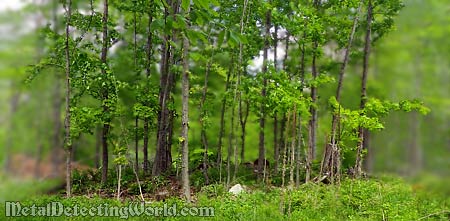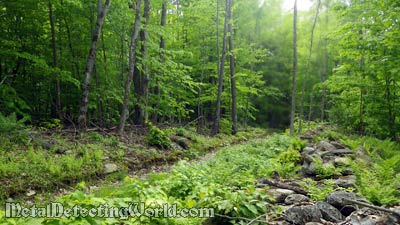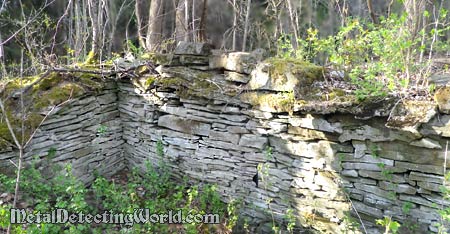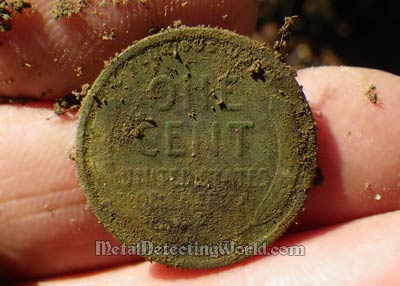Guide To Searching Former Homestead Sites Located in Remote Areas, p. 4
Visual Clues to Cellar Holes of Houses of Category 2 (late 1700s - mid-1800s)
(...CONTINUED from Previous Page)
In my statistics that are based on having searched over 300 of former homestead sites with cellar holes since the early 1990s, most remaining cellar holes of the houses that existed from the late 1700s to the mid-1800s are in a form of an earth mound having the inside hole actually filled with soil and/or small boulders. And, after having lost its square shape with time, the mound might look like a knoll (shown below; I tried to take a better picture to no avail), sometimes overgrown with underbrush and/or trees.

This Knoll with Trees Used To Be an Earth Mound with a Cellar Hole,
Rensselaer County, New York
This particular former homestead site was easily discovered because it is situated right off the former stagecoach road - an abandoned trail now.

Former Stagecoach Road with Stone Walls on Both Sides
Why a majority of cellar holes of this time period are filled with earth and rocks, and actually are not cellar holes? The only explanation that I can come up with is that filling a hole inside the mound with rubble was done to prevent any human or cattle from accidental falling into the hole and getting hurt, especially if the hole was so close to a busy roadway (stagecoach route).
Spotting the mounds/knolls that used to be cellars might be challenging even if they are right off the former roadway, whether it used to be a busy stagecoach road, bluestone-laden wagon trail or just a regular road. If the roadway has been abandoned for many years and turned into a trail with stone walls crumbled down, or without them at all, or turned into a creek (a usual case occurring on steep mountainsides), one should not expect to see the former homestead site situated off such a trail to be in a good shape either.
Of course, the first signs of the former homestead you should look for when you see a knoll/mound are atypical vegetation and/or openings in the stone wall on a roadside. But what next to look for if neither is present at the location in question? It is actually not the "look for" but the "look at". You simply observe geography of a lot in which the mound is situated. If you see that an immediate area around the mound is leveled - somewhat smooth and horizontal, even if the "outer" (outside the lot) terrain surface tilts (slopes), you better start thinking about getting your metal detector ready.
The most important thing to look at is the ground surface. If it is not only smooth but also clean of large rocks and stones of irregular shapes here and there while the outer terrain is littered with them, you can be sure 99.9% that you have got one more hunt site for metal detecting! If you finally turn your machine on, start scanning the area, and receive multiple responses to iron nails, you sure get your 100% now!
Former homestead sites of this time period usually yield a wider variety of coins than the former homestead sites of the category 1 (described on a previous page). Coin shooting around the rubble-filled mounds can bring you any of the following types of coins: late Spanish silver Reales, most varieties of the US Large Cents, Capped Bust and early Seated Liberty US silver coinage, Hard Times tokens, Bank of Upper Canada tokens, and other specie of the period.
And I have to say it again, the above-mentioned approach does not apply only to the former homestead sites of the period in focus. In fact, this approach can be universal for locating many different types of the former dwelling sites scattered in remote areas. It also applies to many sites with cellar holes situated right off the modern roads and highways. It always feels good to see a cellar hole like the one shown below because you always hope for the best even if you are standing nex to an "obvious" spot, and everything tells you, "this cellar is "new", situated next to a modern road, and has been hit 900 million times!"

A "NEW" (ca. late 19th century) Cellar Hole
But you go ahead and start searching around this cellar anyway! If, for any weird reason, your first "diggable" signal turns out to be this...

...You better mobilize yourself to put lots of efforts into painful excavation of a modern "damp" if you do not know what you are doing at that moment! To avoid any ineffectual experience, arm yourself with useful knowledge and put your efforts into real treasure hunting! I hope the following pages will help you get prepared.